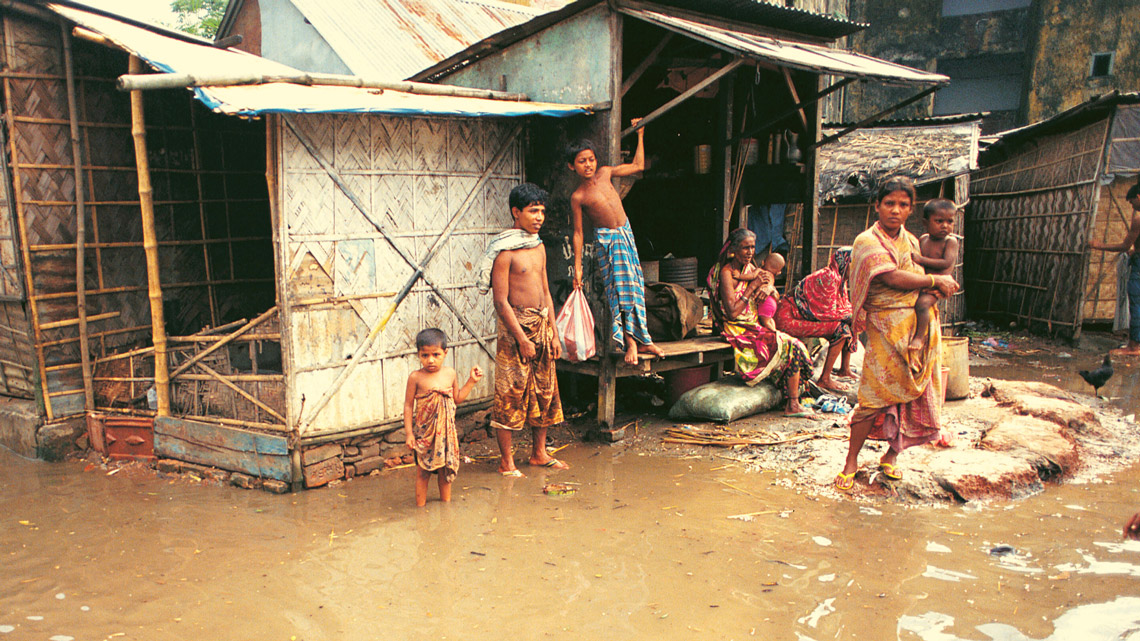Key messages >>>
- If we are able to make right choices to arrest the increase in greenhouse gas emissions now, the impact of sea level rise can be reduced to an extent and so can the number of climate refugees.
- Overall, climate refugees is a problem that still remains unaddressed in the international law, which has the possibility to escalate into a humanitarian crisis, both for the native country and the host country.
- UN Human Rights Committee, ruled that in the absence of active national and international efforts, the individuals in countries at the receiving end of climate change can be considered the victims of human rights violations, thereby triggering the non-refoulement obligations of states.
- There is an urgent need to clearly define the term ‘climate refugee’ in international law and identify the rights of such refugees for any concrete action to be taken. Once that is accomplished, a global fund must be created to provide support for rehabilitation and employment.
Climate Change Impact and Sea Level Rise
Sea level rise in the last few years has been the most visible symptom of climate change. Scientists had already started talking about this from the late 1970s onwards when they first noticed the disintegration of West Antarctic Ice Sheet that had the potential to displace hundreds of people in the coastal cities. The Internal Displacement Monitoring Centre published a statistical research, concluding that a forced displacement of around 26.4 million people has been taking place every year since 2008 because of natural calamities like floods and windstorms. Later on, the Fifth Assessment report of Intergovernmental Panel on Climate Change, published in 2014, estimated a sea level rise in the range of 26 to 82 centimeters from 1986 level to the end of the century.
All this evidence cements a clear case of sea level rise and its implications for the idea of security in international politics, which needs an expanded understanding. For instance, even if steps are taken for climate mitigation on immediate basis, more and more land will continue to be vulnerable to coastal flooding for centuries. This means a minimum-security plan has to be charted out globally. In the current century, as per the research published in Nature journal in 2019, global mean sea level will rise 0.5 m more despite all the reductions in climate emissions and in extreme circumstances, it can be 2 m. Already by 2050, global sea levels are expected to rise by 20-30 cm, which can endanger the lives and land of 150 (140–170) million people. Further it is estimated that by 2300, sea level rise will affect a global population in the range of 1.5% to 5.4%, based on the population numbers until 2100 which has implications for displacement of people. This brings us to the idea of security defined in terms of territory and sovereignty in the context of sea level rise.
Sea Level Rise and Questions of Territory and Sovereignty
Sea level rise presents peculiar set of political problems as opposed to other natural calamities. First and foremost is the question of territory and sovereignty. Countries that are gradually losing land will be faced with the difficult task of defining their territorial jurisdiction in future. For instance, as per the Law of the Sea Convention (LOSC), a state has a claim over the territorial waters up till ‘200 nautical miles from the baseline’. So, losing land to sea level rise might result in a reduced territorial jurisdiction, against which no sufficient remedy is currently available in international law. In this regard, many legal scholars have found the definition and laws pertaining to baselines in LOSC inadequate and have suggested a revision of the same.
As far as the inhabitants of Small Island countries are concerned, sea level rise will mean absolute statelessness in some cases, thus further complicating the idea of citizenship for them. Questions like, the process or criteria for acquiring citizenship for displaced people; consideration of cultural affinity to the neighboring countries in rehabilitating displaced population; entitlements of climate refugees in the host country until they get citizenship, will require the construction of a comprehensive policy structure. One proposal of such a policy is the novel idea of ‘climate passport’ suggested by Dirk Messner, President of the German Environment Agency, so as to allow mobility to climate refugees until they get the citizenship of a country.
Climate Refugees and International Law
As of now, there is no international legal recognition to ‘climate refugees’ despite the fact that ‘environmental refugees’ as a term has been used regularly by a number of NGOs in their position papers, academicians and media reports, since the 1970s to bring attention to forced displacement due to environmental factors. Despite the usage of the term in public discourse, the 1951 Refugee Convention makes no mention of environmental factors as a reason for displacement. Even Paris Agreement has failed to recognize this particular group and has limited its provisions to “developing recommendations for integrated approaches to avert, minimize and address displacement related to the adverse impacts of climate change”, as mentioned in Article 50.
Nonetheless, the issue of the rights of climate refugees has reached the doors of the office of United Nations. The Republic of Kiribati in the Pacific has been facing devastating impacts of rising sea level to the point of becoming almost inhabitable. It might soon become the first country to be completely submerged under the sea. As a result, one of its citizens, IoaneTeitiota, sought refugee status in New Zealand in 2013, presenting the case that his family members’ life is endangered because of the rising sea level. The application was, however, rejected by the Immigration and Protection Tribunal of New Zealand, a decision also supported by the Supreme Court.
The complaint was then communicated to UN Human Rights Committee, which ruled that in the absence of active national and international efforts, the individuals in countries at the receiving end of climate change can be considered the victims of human rights violations, “thereby triggering the non-refoulement obligations of sending states.” The principle of non-refoulment, the touchstone of international law on refugees, guarantees a person’s right to not be returned back to a country where he/she is threatened with “torture, cruel, inhuman or degrading treatment/punishment.” Furthermore, the Committee recognized that the possibility of an entire country submerging under the water is a risk so extreme that the “conditions of life in such a country may become incompatible with the right to life with dignity before the risk is realized.” Hence, the ruling underlined the violation of the rights of an individual not just when the calamity has taken place, but even before that.
Apart from the above important observations, the Committee also reiterated articles 6 and 7 of the International Covenant on Civil and Political Rights that ensure the inherent right to life of an individual. On the whole, it was the first time that existing legal principles were applied to acknowledge the rights of climate refugees who might face imminent danger due to climate change. Sadly, in this case, in spite of acknowledging the rights of ‘climate refugees’, the request of the complainant was turned down by the UN Human Rights Committee based on the argument that the concerned person did not face ‘imminent danger’ in the given circumstances.
So, although international organizations have been proactively pushing forward the agenda on climate change, member states have been reluctant to make drastic commitments. However, some countries are now recognizing the massive displacement they will face in future as a result of sea level rise. In this respect, Bangladesh has already started working on a mega building project called BisheshAsrayanPrakalpa, which aims to provide shelter to thousands of climate refugees and generate employment for them in the process, thereby also reducing poverty. Other refugee related solutions can be humanitarian visas, temporary protection measures, signing of regional and bilateral free movement agreements and many more.
Such initiatives should be considered by all countries given that cross-border climate migration will open up new pathways and corridors, that are vulnerable to criminalization, exploitation of women and children, human trafficking and the expansion of slums as well as homelessness, especially in the absence of proper jobs or even work permit for refugees. Worst case scenario, as even noted by United Nations, could be the possible fall of governments due to wars and social chaos multiplied by climate change. Countries on relatively higher grounds with stable governments will then have the choice to either allow these displaced people inside their borders or seal off their borders, trapping thousands of people in highly unlivable conditions, some leading to sure death. The latter choice already seems to be driving the populist agenda across the world, which not only raises ethical questions but also questions about the future of globalization and world economy. Considering these long-term implications, refugee management must form an integral part of a country’s climate change adaptation and mitigation policy.
The Way Forward
There is an urgent need to clearly define the term ‘climate refugee’ in international law and identify the rights of such refugees for any concrete action to be taken. And given the minute complexities of law, it is important that a distinction is made between climate refugees and climates migrants, as the status of a refugee will entail the application of critical legal provisions like the principle of non-refoulement. Once that is accomplished, a global fund must be created to provide support for rehabilitation and employment. Only if instrumental changes are made in the international law with regards to climate refugees, a trickle-down effect can take place in terms of domestic laws on the official acceptance of such refugees in the host countries.
If we are able to make right choices to arrest the increase in greenhouse gas emissions now, the impact of sea level rise can be reduced to an extent and so can the number of climate refugees. Overall, climate refugees is a problem that still remains unaddressed in the international law, which has the possibility to escalate into a humanitarian crisis, both for the native country and the host country. Hence, it will be pragmatic on the part of governments worldwide to treat climate refugees as one of the key issues in their national climate change policy and response.



